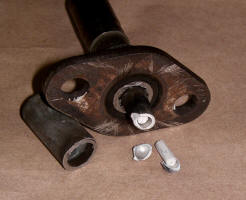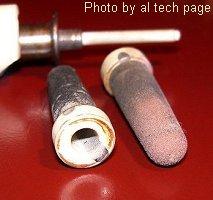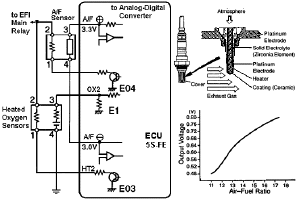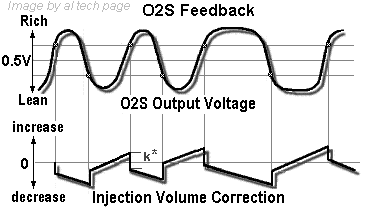Oxygen Sensors
As is known, correct work of the petrol engine needs the certain ratio between volumes of acting fuel and air. The ratio (14,7:1) theoretically is the optimal by criterion of full combustion and refers to as factor of surplus of air a =1 (rice 1). Purpose (assignment) of an electronic control system by submission of fuel is maintenance of this ratio in a proportion most appropriate to temperature conditions, loading on the engine, to sufficient dynamics (changes) of dispersal, requirements of profitability and protection of an environment.
The factor of surplus of air a,
is measured by Oxygen Sensor (O2S) which is
located in a final collector. At a=1
the mix is optimum (rice 2). On some types of automobiles after the catalyst the
additional gauge for the account of "ageing" of the basic and the
analysis of a condition of the catalyst is established. Depending on a pressure
(voltage) of a probe, ECM corrects parameters of a fuel-air
mix.
At warm the engine and
serviceable system fuel injection system, ECM and a probe are in the closed
system of regulation, i.e. in a mode with the closed
feedback - "Closed Mode". ECM
constantly traces a target voltage of a probe. At increase of this voltage
- reduces time of opening of atomizers. At too poor mix (a low target pressure
(voltage) of a probe) - increases a little.
At faulty Oxygen Sensor
ECU passes in a mode at which indications of a probe are not taken into account
for definition of parameters of a fuel-air mixture (i.e. a mode without a
feedback on a target voltage of the gauge of the maintenance (contents) of oxygen
- " Open Loop ").
Attempts
of replacement of "regular" probe
O2The simulator
on engines 1G-GE, 3S-FE have shown, that at the best ECU ignores "...
brains " at submission on his (its) input (entrance) of pulses of a
voltage of the appropriate frequency, amplitude and duration and from enough
high-resistance source.
The ambassador connection of the simulator on appropriate input (entrance)
ECM pulses of a voltage, BUT absolutely not synchronously with his (its) attempts
to change structure of a mix act. At submission of a constant voltage from an
external source (for example, from the parametrical stabilizer on the
diode),
changes of a voltage DO NOT OCCUR at all! I.e. ECM in general "does not
see" change of structure of a fuel mix that should occur at absence of
submission of fuel in a mode compulsory idle (in a situation at which the pedal
of gas is released (let off), but revolutions of the engine still big).
As consequence (investigation),
in both cases it (he) passes from a mode " with a feedback " in a
mode at which indications of the Oxygen Sensor
are not taken into account at
management of submission of fuel. Described reaction ECM to the simulator
is characteristic not only for Toyota, but also for
fuel injection systems of other manufacturers.
Zirconia Oxygen Sensor represents the ceramic case in which platinum electrodes are established. One of them is in a stream of exhaust gases, and the second in an atmosphere. At high temperature ceramics ZrO2 Alloyed is firm electrolyte, i.e. will carry out (spend) ions of oxygen. Between platinum electrodes the potential difference which characterizes a degree of enrichment of a fuel-air mix (Rice 2) is created. Application Pb gasoline in systems with is inadmissible, since causes "poisoning" of platinum.
In some engines probes with heaters
electrodes are used (HO2S). The active ceramic element of such probe has an internal heater that indications of a probe were authentic even at low
temperature of the fulfilled gases. It is nece ssary to note, that decrease
(reduction)
of sensitivity, reduction of speed) ECU does not fix some malfunctions Oxygen
Sensor. Therefore and
to judge serviceability it is possible only after the appropriate check
instead of to be limited only to reading of codes of self-diagnostics.
ssary to note, that decrease
(reduction)
of sensitivity, reduction of speed) ECU does not fix some malfunctions Oxygen
Sensor. Therefore and
to judge serviceability it is possible only after the appropriate check
instead of to be limited only to reading of codes of self-diagnostics.
To check
a target voltage (an oscilloscope, a tester) it is necessary being
connected to for an alarm wire of a probe at working and warm
the engine. In figure it is given diagrams of a target voltage of the gauge of
the maintenance (output voltage) of Oxygen
Sensor (k4), revolutions (rpm) of the engine (W2), time (injectors pulse) of opening of
injectors (t5) at idle for engine. Appreciably, that the system functions
at the closed feedback on day off of a pressure (voltage) of a probe ("
closed mode "). ECU reduces time of opening of injectors at increase of
target output voltage from the Oxygen
Sensor. And on the
contrary, at a poor mix - increases.
From higher told follows, that in this mode authentic check of speed (a constant of time) the gauge IS NOT POSSIBLE. Time of increase (as well as time of reduction) his (its) target voltage depends not only and not so much on his (its) dynamic properties, and from a "program" constant of time fuel injection systems. I.e. from step-type behavior of an increment of duration of the following pulse of a voltage managing an atomizer. Check of speed of a probe on his (its) target voltage is possible (probable) only at the analysis of his (its) target voltage after " compulsory single " a course or at Vf1-diagnostics.
The resource of the gauge of the maintenance (contents) of oxygen in exhaust gases usually makes tens thousand kms and substantially depends on conditions of operation. Decrease (reduction) of a resource of probes provokes application Pb gasoline, low standard oil rings, hit in exhaust system antifreeze. Resistance of a heating element usually makes from 1.2 up to 15 Ohm.
Oxygen Sensor is increase of the charge of fuel,
increase of the maintenance (contents) WITH, deterioration of dynamics (changes)
of dispersal of the automobile, occurrence unstable idling. Thus reading the
appropriate code of malfunction is possible at initialization
of self-diagnostics. Malfunction of a probe can provoke failur e of
the catalyst converter and (or) cause wrong functioning of EGR system.
e of
the catalyst converter and (or) cause wrong functioning of EGR system.
Independent check of a condition of a probe is possible (probable). Check of a condition of a probe at diagnostics of the reasons of malfunction of fuel system by technicians HUNDRED - is obligatory. But before its (her) realization it is necessary to learn (find out) quotations for the herein provided diagnostic works.
" Round eyes " or arrangements: "... And what for to you it to
check... " Should guard at an estimation of qualification of executors and
desire to
 concern them. The diagnosis: "... At you " dead Lambda... " Should prove to be true in
objective parameters, instead of simply "argument": - I so see...
concern them. The diagnosis: "... At you " dead Lambda... " Should prove to be true in
objective parameters, instead of simply "argument": - I so see...
I
pay your attention that before manufacturing of an adapter for use of Oxygen
Sensor from BOSCH under the sketch
lexa38.narod.ru/lambda_k.html , measure distance centre to centre
fixing apertures of a "native" probe. At the top probe it is equal 44
mm, at the bottom 38 mm.
Check up an oscilloscope a target voltage of a probe at idle and
at compulsory idle - deceleration (i.e. at the released pedal of accelerator, but
enough the big revolutions of the engine when it is carried out "not"
submissions of fuel) and compare to diagrams:
|
|
Conclusion about necessity of replacement Oxygen Sensor only on the basis of that " his (its) constantly low target voltage at idle " - premature. This necessary, but not a sufficient condition of replacement. For example, at not tightness of an inlet collector (so-called "...air ") the engine will work at too poor mix, a target voltage of a probe will be low, but the probe thus "will be not guilty"...
If the target voltage of a probe on idle engine constantly is more 0,5. 0,6 Volt it is necessary to check up time of opening of atomizers on idle, pressure in fuel system, standard of the gauge of temperature for ECU, the gauge of underpressure or a stream of air to be convinced of tightness of atomizers.
If a Heaters Oxygen Sensor (3 or 4 contact), check up resistance of
a heater of a probe and receipt on him (it) (on a heater) voltage 12 V.
If
as a result of carried out (spent) diagnostics appears that the probe it is
necessary to replace it (him) is faulty. The variant malfunctions of the catalyst
or his (its) Overwarm-gauge is not excluded. Sometimes the reason of that
the indicator "Check
Engine " ("MIL") continues to shine at the entered
engine, negligence of technicians is at realization of repair work. For example
inclusion of ignition at the removed (taken off) socket of any unit injection
systems, including and Oxygen Sensor.
The target voltage of a probe can be checked up the voltmeter or the indicator.
Positive experience of replacements of "native" probes on " Lambda-probes "BOSCH" LSH 25 0 258 005 133 " (4 contact, 2 white wires - heater, black - output, grey - gnd and availability of their price, allows to recommend this variant as alternative to purchase "firm" Oxygen Sensor. At least, you risk 4 hundred RUR, instead of 100-240 US$.
In Moscow market " Southern port " is flooded enough with these gauges of the maintenance(contents) of oxygen and on quite reasonable price (400 RUR).
Look diagrams of a target pressure(voltage) of probes and practice of their replacement on engines Mazda Mitsubishi
|
Gauges of the maintenance (contents) of oxygen in exhaust gases - Oxygen Sensor |
|||
|
Mitsubishi |
|||
At replacement by 4 contact probe it is necessary one wire of a heater and gnd ("minus") it is reliable to connect to the case of the automobile. The second wire of a heater is necessary for connecting to contact, on which always "+" after inclusion "IGN". Connection to contact "+" coils of ignition is inexpedient, since some systems use additional "extinguishing" resistance in a circuit of a feed (meal) of the coil, and also because of substantial growth ... loadings on this electric circuit at cold heater Oxygen Sensor. Connection to contacts of the fuel pump sometimes toilfully enough. In my opinion, it is necessary to use contact "IGN1,2" the lock of ignition.
The technique of check of a condition of , the description of basic differences titania and zirconia Oxygen Sensor (Lambda-probes are stated in a separate material. Parameters of Lambda-probe BOSCH for fuel Inject. systems the VAZ are given in a separate note.
 It
agrees Toyota factory service manuals since 1997 in Fuel-Inject. systems of
automobiles let out under standards California-emission, it is used AIR/FUEL
(A/F) sensors. The A/F
sensor signal voltage varies accordingto the amount of oxygen sensors in the
ehhaust stream (see figure). Unlike the signal voltage from a heated oxygen
sensors (HO2S), the A/F sensors signal voltage increases as the air-fuel
mixture leans and decreases as the air-fuel mixture richens. The signal voltage
ranges from 0.48 to 0.80 volts! In
a 1999 Camry voltage
that corresponds with a specific A/F ratio is above (to 4.0 Volts).While the vehicle runs in closed loop mode, the
ECU uses the A/F sensor signal to lengthen or shorten the fuel injector pulse
width until attaining a stoichiometric air-fuel mixture.
It
agrees Toyota factory service manuals since 1997 in Fuel-Inject. systems of
automobiles let out under standards California-emission, it is used AIR/FUEL
(A/F) sensors. The A/F
sensor signal voltage varies accordingto the amount of oxygen sensors in the
ehhaust stream (see figure). Unlike the signal voltage from a heated oxygen
sensors (HO2S), the A/F sensors signal voltage increases as the air-fuel
mixture leans and decreases as the air-fuel mixture richens. The signal voltage
ranges from 0.48 to 0.80 volts! In
a 1999 Camry voltage
that corresponds with a specific A/F ratio is above (to 4.0 Volts).While the vehicle runs in closed loop mode, the
ECU uses the A/F sensor signal to lengthen or shorten the fuel injector pulse
width until attaining a stoichiometric air-fuel mixture.
The A/F sensor containts a ECU-controlled heater. At start-up, the heater helps warm the A/F sensors to quickly operating temperature. With minimal exhaust gas flow, the heater keeps the A/F sensor from cooling down. Other inform is in http://alflash.com.ua/o2calif.htm
Practically all is clear without translation, but it does not explain why, for example, for
At check of the described gauge (A/F sensor) it is necessary to take into account, that at him (it) "return" dependence of a target voltage in comparison with usual zirconia probes.
 The new Oxygen Sensors as know as "Super
Stability O2 Sensor"
The new Oxygen Sensors as know as "Super
Stability O2 Sensor"
|
|
2000-2018
al tech page
